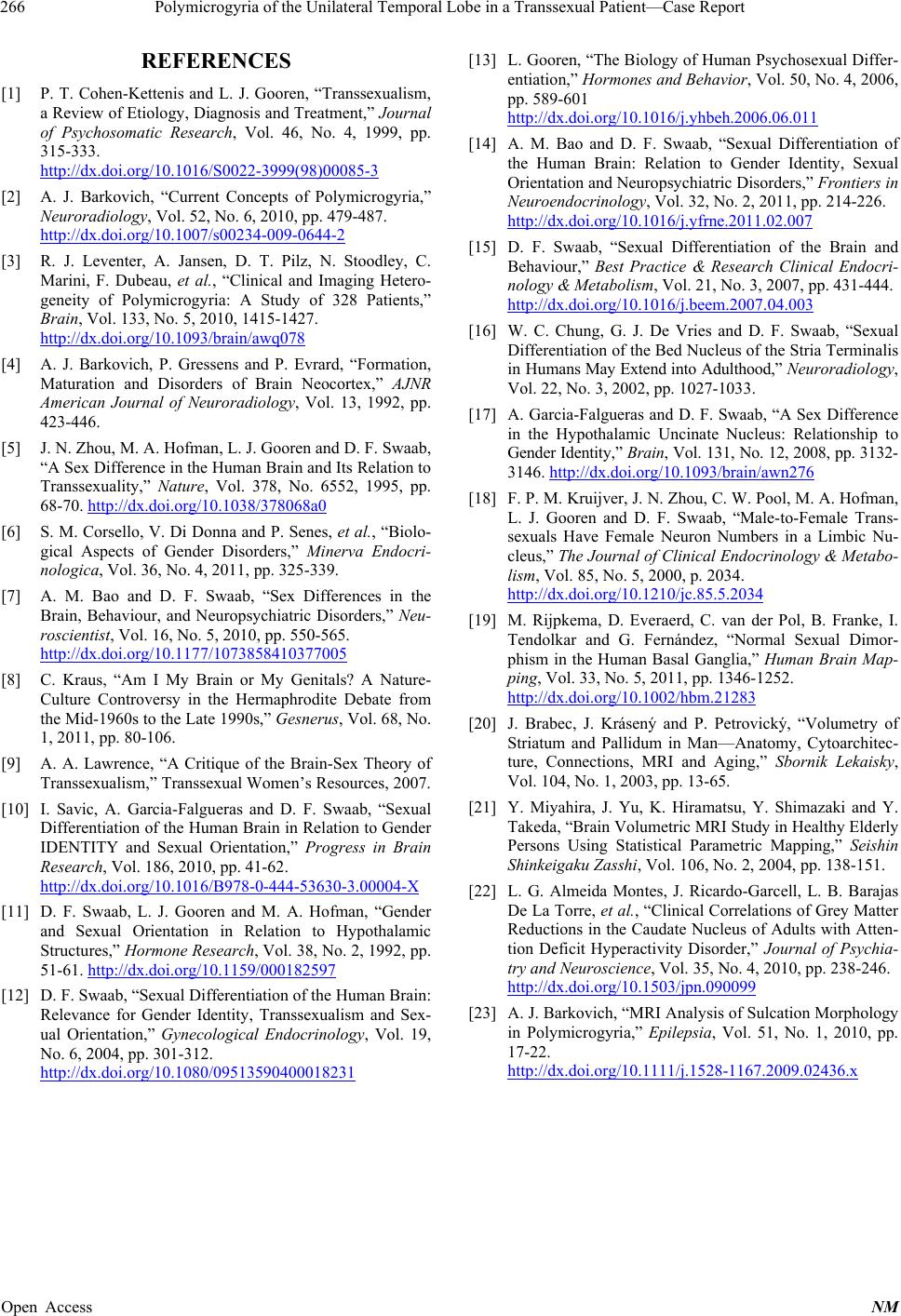
Polymicrogyria of the Unilateral Temporal Lobe in a Transsexual Pa ti en t—Case Report
266
REFERENCES
[1] P. T. Cohen-Kettenis and L. J. Gooren, “Transsexualism,
a Review of Etiology, Diagnosis and Treatment,” Journal
of Psychosomatic Research, Vol. 46, No. 4, 1999, pp.
315-333.
http://dx.doi.org/10.1016/S0022-3999(98)00085-3
[2] A. J. Barkovich, “Current Concepts of Polymicrogyria,”
Neuroradiology, Vol. 52, No. 6, 2010, pp. 479-487.
http://dx.doi.org/10.1007/s00234-009-0644-2
[3] R. J. Leventer, A. Jansen, D. T. Pilz, N. Stoodley, C.
Marini, F. Dubeau, et al., “Clinical and Imaging Hetero-
geneity of Polymicrogyria: A Study of 328 Patients,”
Brain, Vol. 133, No. 5, 2010, 1415-1427.
http://dx.doi.org/10.1093/brain/awq078
[4] A. J. Barkovich, P. Gressens and P. Evrard, “Formation,
Maturation and Disorders of Brain Neocortex,” AJNR
American Journal of Neuroradiology, Vol. 13, 1992, pp.
423-446.
[5] J. N. Zhou, M. A. Hofman, L. J. Gooren and D. F. Swaab,
“A Sex Difference in the Human Brain and Its Relation to
Transsexuality,” Nature, Vol. 378, No. 6552, 1995, pp.
68-70. http://dx.doi.org/10.1038/378068a0
[6] S. M. Corsello, V. Di Donna and P. Senes, et al., “Biolo-
gical Aspects of Gender Disorders,” Minerva Endocri-
nologica, Vol. 36, No. 4, 2011, pp. 325-339.
[7] A. M. Bao and D. F. Swaab, “Sex Differences in the
Brain, Behaviour, and Neuropsychiatric Disorders,” Neu-
roscientist, Vol. 16, No. 5, 2010, pp. 550-565.
http://dx.doi.org/10.1177/1073858410377005
[8] C. Kraus, “Am I My Brain or My Genitals? A Nature-
Culture Controversy in the Hermaphrodite Debate from
the Mid-1960s to the Late 1990s,” Gesnerus, Vol. 68, No.
1, 2011, pp. 80-106.
[9] A. A. Lawrence, “A Critique of the Brain-Sex Theory of
Transsexualism,” Transsexual Women’s Resources, 2007.
[10] I. Savic, A. Garcia-Falgueras and D. F. Swaab, “Sexual
Differentiation of the Human Brain in Relation to Gender
IDENTITY and Sexual Orientation,” Progress in Brain
Research, Vol. 186, 2010, pp. 41-62.
http://dx.doi.org/10.1016/B978-0-444-53630-3.00004-X
[11] D. F. Swaab, L. J. Gooren and M. A. Hofman, “Gender
and Sexual Orientation in Relation to Hypothalamic
Structures,” Hormone Research, Vol. 38, No. 2, 1992, pp.
51-61. http://dx.doi.org/10.1159/000182597
[12] D. F. Swaab, “Sexual Differentiation of the Human Brain:
Relevance for Gender Identity, Transsexualism and Sex-
ual Orientation,” Gynecological Endocrinology, Vol. 19,
No. 6, 2004, pp. 301-312.
http://dx.doi.org/10.1080/09513590400018231
[13] L. Gooren, “The Biology of Human Psychosexual Differ-
entiation,” Hormones and Behavior, Vol. 50, No. 4, 2006,
pp. 589-601
http://dx.doi.org/10.1016/j.yhbeh.2006.06.011
[14] A. M. Bao and D. F. Swaab, “Sexual Differentiation of
the Human Brain: Relation to Gender Identity, Sexual
Orientation and Neuropsychiatric Disorders,” Frontiers in
Neuroendocrinology, Vol. 32, No. 2, 2011, pp. 214-226.
http://dx.doi.org/10.1016/j.yfrne.2011.02.007
[15] D. F. Swaab, “Sexual Differentiation of the Brain and
Behaviour,” Best Practice & Research Clinical Endocri-
nology & Metabolism, Vol. 21, No. 3, 2007, pp. 431-444.
http://dx.doi.org/10.1016/j.beem.2007.04.003
[16] W. C. Chung, G. J. De Vries and D. F. Swaab, “Sexual
Differentiation of the Bed Nucleus of the Stria Terminalis
in Hu ma ns May Extend int o Adulthood,” Neuroradiology,
Vol. 22, No. 3, 2002, pp. 1027-1033.
[17] A. Garcia-Falgueras and D. F. Swaab, “A Sex Difference
in the Hypothalamic Uncinate Nucleus: Relationship to
Gender Identity,” Brain, Vol. 131, No. 12, 2008, pp. 3132-
3146. http://dx.doi.org/10.1093/brain/awn276
[18] F. P. M. Kruijver, J. N. Zhou, C. W. Pool, M. A. Hofman,
L. J. Gooren and D. F. Swaab, “Male-to-Female Trans-
sexuals Have Female Neuron Numbers in a Limbic Nu-
cleus,” The Journal of Clinical Endocrinology & Metabo-
lism, Vol. 85, No. 5, 2000, p. 2034.
http://dx.doi.org/10.1210/jc.85.5.2034
[19] M. Rijpkema, D. Everaerd, C. van der Pol, B. Franke, I.
Tendolkar and G. Fernández, “Normal Sexual Dimor-
phism in the Human Basal Ganglia,” Human Brain Map-
ping, Vol. 33, No. 5, 2011, pp. 1346-1252.
http://dx.doi.org/10.1002/hbm.21283
[20] J. Brabec, J. Krásený and P. Petrovický, “Volumetry of
Striatum and Pallidum in Man—Anatomy, Cytoarchitec-
ture, Connections, MRI and Aging,” Sbornik Lekaisky,
Vol. 104, No. 1, 2003, pp. 13-65.
[21] Y. Miyahira, J. Yu, K. Hiramatsu, Y. Shimazaki and Y.
Takeda, “Brain Volumetric MRI Study in Healthy Elderly
Persons Using Statistical Parametric Mapping,” Seishin
Shinkeigaku Zasshi, Vol. 106, No. 2, 2004, pp. 138-151.
[22] L. G. Almeida Montes, J. Ricardo-Garcell, L. B. Barajas
De La Torre, et al., “Clinical Correlations of Grey Matter
Reductions in the Caudate Nucleus of Adults with Atten-
tion Deficit Hyperactivity Disorder,” Journal of Psychia-
try and Neuroscience, Vol. 35, No. 4, 2010, pp. 238-246.
http://dx.doi.org/10.1503/jpn.090099
[23] A. J. Barkovich, “MRI Analysis of Sulcation Morphology
in Polymicrogyria,” Epilepsia, Vol. 51, No. 1, 2010, pp.
17-22.
http://dx.doi.org/10.1111/j.1528-1167.2009.02436.x
Open Access NM